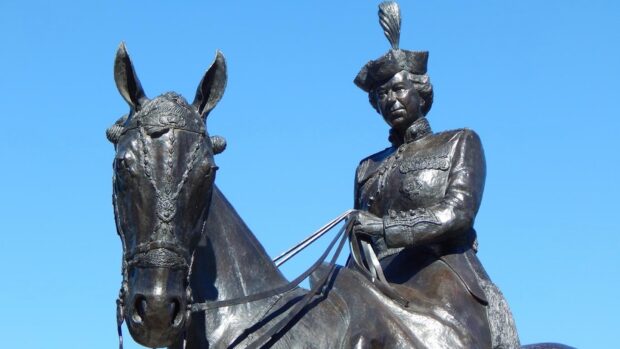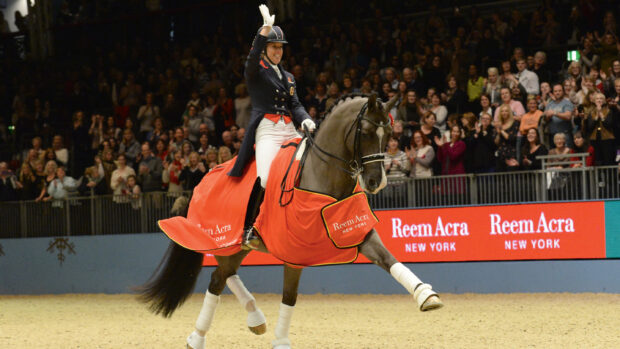A war correspondent who was lured away from the BBC to Horse & Hound with the bait of a “company horse” and free hunting, Michael Clayton was both a pioneer and an able horseman, and a leader within the horse industry
Michael Clayton began his journalistic career on the south coast, on the Poole Herald and Bournemouth Times with Gordon Williams, whose later novel, The Siege of Trencher’s Farm, became the Oscar-nominated film Straw Dogs. The duo both progressed to Fleet Street, sharing a flat in Earls Court with Ian Wooldridge; the iconic sports writer often monitored his old friend’s scrapes in the hunting field in the Daily Mail.
After a stint as news editor on the London Evening News, Michael moved into broadcasting, presenting the BBC Today programme and working as a war correspondent in Vietnam and the Middle East.
During the 1960s, he had started to contribute hunting reports to The Field. This lapsed briefly in1970, when he was unavoidably detained under siege in Amman, Jordan.
Brought up in Dorset and around the New Forest, Michael had a grass-kept pony and was encouraged along to hill meets with the Portman by Sir Peter Farquhar. He showed the teenaged Michael round the kennels, igniting a lifelong interest in hound pedigrees and the art of venery, which enriched Michael’s love of hunting way beyond the thrill of cross-country riding.
While at the BBC, he began hunting with the Whaddon Chase and struck up a lifelong friendship with their joint-master Dorian Williams, probably the greatest innovator the horseworld had ever seen.
Horse & Hound’s third Editor
When retirement loomed in 1973 for longstanding H&H Editor Walter Case, Dorian recommended Michael to be its third-ever editor. Then, as now, it was unusual for a BBC man to abandon the fast lane for a specialist periodical. But from Michael’s perspective, free hunting was considerable bait: he got a company horse as well as a company car.
But it was a shrewd appointment. Equestrian sport was entering a new, professional era, and a charismatic and tenacious hard-news journalist would keep it up to scratch. Although he was close to many top figures, Michael never baulked from criticising decisions he perceived – usually correctly – to be flawed. He was quick to highlight such hypocrisies as the “shamateurism” then prevalent in showjumping.

Michael Clayton was Horse & Hound’s third Editor.
Powerful figures such as Col Sir Mike Ansell, Sir Harry Llewellyn and Raymond Brooks-Ward’s business partner, Bob Dean, took the “new editor” – as he continued to be known for a decade – to endless Cavalry Club suppers to “fill him in” on horseworld politics. For 15 years they failed to extract the identity of Loriner, Michael’s punchy weekly columnist, who knew too much about goings-on in the corridors of power. Loriner was, of course, Dorian, who died in 1985. Michael still missed him deeply, 25 years on.
Apart from being an able horseman, Michael’s onerous life at the BBC equipped him for the role of hunting correspondent. He wrote: “This is the only form of sports reporting in which the journalist is on the rigorous field of play, taking the same risks as everyone else on a strange horse in an unfamiliar country. Using an old hunting saddle, with no knee pads, and badly lacking a double bridle, riding a strong puller was ‘the image of war with 25% of the danger’, as Surtees described the hunting field.”
He went on to hunt with 230 packs in Britain, Ireland and the USA, “the most wonderful privilege and pleasure”. In one season, he hunted 42 horses with 25 packs, managing on hirelings and often young horses as experienced spares became a rare commodity towards the end of the 1990s.

Also known as “Foxford”, Michael – pictured on Grand National runner-up Crisp – began a hunting column in H&H, taking the pen name from his own hunter.
He quickly understood the coded messages that often accompanied his arrival at the meet. A suggestion that “you won’t find anything like Leicestershire down here”, usually meant a metaphorical bear-trap was in store. He caused great satisfaction in an East Anglian harrier country with “nothing to jump” when his horse dived to the bottom of one of their cavernous ditches.
But his timing was impeccable. He once wrote: “The 1970s was a wonderful decade for foxhunting, worthy of past glories: the political threat was negligible; much encouraged by Ronnie Wallace, there was a surge of newly appointed young masters who hunted hounds; and the best hunting terrain had so far escaped the worst onslaughts of development. Then, we regularly jumped in and out across the A46 in the Quorn country to reach wonderful old turf and fences each side; now, it’s a four-lane highway bearing heavy traffic.”

For years, Michael – pictured on Calgary Gold, a hunting stallion – hunted in a top hat until he switched to a BSI-approved crash cap.
Michael began a weekly hunting column, taking his pen name from his own hunter Foxford, who was too bold for his rider’s good, often carting him embarrassingly upsides the field master. Foxford was succeeded by Josephine and then her offspring, including the coloured horse Monty, who was given his own column in H&H.
A technophobe, but ahead of his time
Politically, Michael was way ahead of his time in calling (not always successfully) for the introduction of organised sport horse breeding; a more subtle form of hunt dress to mitigate niggling elitist criticisms; and agricultural status – with consequent tax advantages – for the horse. An advocate of a Tote monopoly after seeing the knock-on benefits of the pari-mutuel for elite equestrianism in France, Michael remained frustrated by the absence of joined-up thinking between racing and equestrianism. He was instrumental in initiating the British Horse Industries Confederation, to act as a joint lobby to Government, but it never acquired the teeth Michael hoped.
For years he hunted in a top hat, but, when safety became a big issue, he was happy to endure the mirth of fellow followers to sport a BSI-approved crash cap and practise what he preached in the magazine. Michael shook off a lot of broken bones – like many tall people, when he fell, he fell heavily – though one of his most troublesome knee injuries was incurred during a boisterous game of table-tennis at kennels after a meet was frosted off.

Michael Clayton hunting with the Belvoir in 2004.
Michael tolerated a lot of back pain to keep hunting into his late sixties before calling it a day. He began a short era of long-haul winter travel to keep his mind off what he was missing.
He also relished the different kind of sport to be found in office politics. H&H was acquired by a major corporation early during his tenure and, right up to retirement, Michael fought – and won – many boardroom battles to keep H&H at the vanguard of modern publishing techniques, often stealing a march from bigger titles in the group.
In 1984, photographer Kit Houghton wanted to try new satellite technology to beam colour pictures from the Los Angeles Olympic Games. Michael was the only magazine editor in Europe to accept the challenge, holding the presses for the front cover – the gamble worked, winning H&H an industry award.
Contrarily, Michael himself was a hopeless technophobe, providing colleagues with many involuntary comedy moments. Once, struggling to photocopy a ream of personal bank statements, he was mortified to discover he had faxed them to our printers instead.
A pioneer in the horse world
Michael was proud of H&H’s links with the royal family, further cemented by H&H’s long-term support of the Grand Military Gold Cup in which there were frequent royal runners and even riders. For some years a carriage arrived at our offices in King’s Reach Tower every Thursday to collect two copies for Buckingham Palace. The Queen and the Duke of Edinburgh visited the offices in the 1970s, and the Queen Mother in 1986.

Michael hosted a visit by The Queen Mother to the H&H offices in 1986.
Michael was, though, far from a traditionalist and, in cahoots with Lt-Col Sir John Miller, the Crown Equerry, he arranged the first-ever “tour” to Britain by “horse whisperer” Monty Roberts; what a phenomenon that spawned.
Journalists set themselves up to criticise the actions of governing bodies. Michael was potentially on the receiving end when, upon retirement from H&H, he became chairman of the British Horse Society (BHS), just as it was forced to reinvent itself with the departure of dressage, eventing and the Pony Club.
Desi Dillingham, former president of the BHS and former chairman of British Dressage, said: “He took over the reins just as radical change was sweeping the horseworld. The advent of World Class funding – the strengthening of the British Equestrian Federation – gave the BHS one of its most difficult times, but Michael held it together. Today, the BHS is thriving and a lot of that is down to his leadership.”
Though he had left H&H by the time the hunting ban became a reality, he continued to contribute to its campaign, bringing his broadcasting skills to bear as an orator out in the field and as chairman of the Cottesmore Hunt. In 2009, it particularly amused him to take part in the Game Fair debate entitled: “The BBC – friend or foe to hunting?”

Not only was Michael popular with his peers, he fought tirelessly to keep H&H at the vanguard of publishing techniques, which led to the magazine winning an industry award.
Michael wrote hunting books, lavishly illustrated by the legendary “running” Jim Meads and, after Jim’s retirement, Trevor Meeks, who Michael had recruited from the world of motor sport to embrace a new approach to equestrian photography.
Michael also authored equestrian biographies and practical manuals, notably Hickstead – The First 12 Years, with Dick Tracey, a biography of Stroller, and helped to research Dorian’s book Great Riding Schools of the World. This year he finally penned his memoirs, My Life in the News: from Village Fete to the Front Line (Merlin Unwin). He saw for himself Warendorf and other major Continental centres of excellence, remaining acutely disappointed there was nothing like them in the UK.
Michael was married three times, first to Mary Watson a fellow news reporter, to Jane Ryman, whom he met at the Horse & Hound Ball, and latterly and very happily to Marilyn Crowhurst, an estate agent whom he met when launching a property column in H&H.
He had two gifted children from his first marriage – Marcus, who won a place at the Royal Ballet School, and Maxine, who followed her parents into TV news reporting in New Zealand – and a step-daughter, Georgina.
Michael died on 19 December 2022. A private funeral has since taken place.




